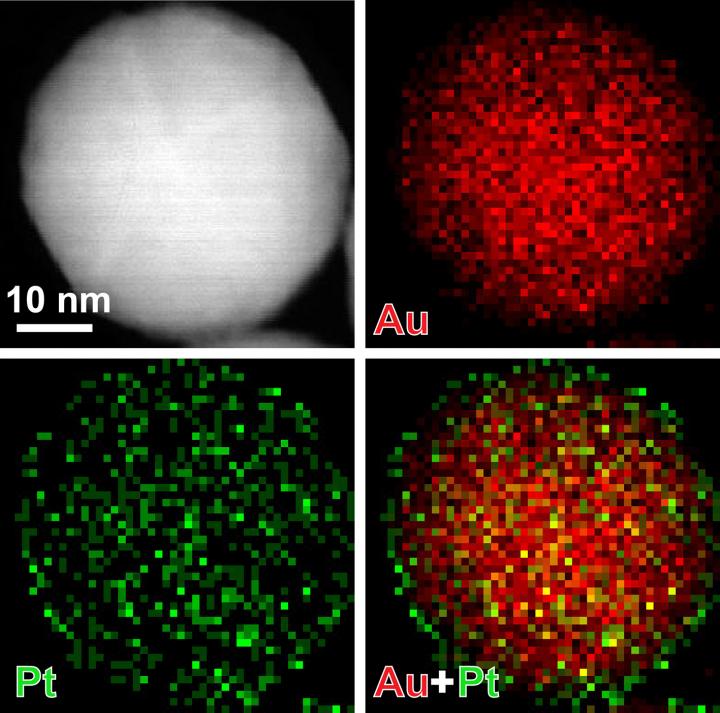Test strips for cancer detection get upgraded with nanoparticle bling

By coating gold nanoparticles in thin layers of platinum, only a few atoms thick, Xiaohu Xia's team was able to increase the sensitivity of test strips that detect prostate-specific antigen (PSA). Credit: Xiaohu Xia/Michigan Tech
However, there's a lot more hCG in pee than there is of cancer biomarkers in blood. Identifying minute concentrations is the greatest challenge of test strips that have been developed to detect everything from cancer to infectious diseases to heart problems. The actual stripe on the paper simply isn't sensitive enough to change color for a human eye to easily see it at concentrations that make a life-changing difference.
Some nanoparticle bling could change that. And it would not greatly impact the cost of current test strips according to new research led by Xiaohu Xia, an assistant professor of chemistry at Michigan Technological University. The research was published recently in Nano Letters.
Gold nanoparticles have been used widely for decades for in vitro diagnostics to make medical care and treatment decisions quicker and easier for physicians and patients. What is new with Xia's research is adding a dual function to the nanoparticle by decorating each tiny sphere in a thin skin of platinum.
Doing so makes it easier for the naked eye to observe changes on the test strip. It also increases the accuracy and provides quantifiable results for extremely low concentrations of key biomarkers, which are measured in picograms per milliliter. In Xia's study, they focused on prostate-specific antigen (PSA), looking for signals of mere trillionths of a gram in a single drop of blood.
“We require the detection to be very sensitive,” Xia says, explaining that platinum is a great catalyst and a little goes a long way to boost the chemical reaction that causes a test strip stripe to show up. “Gold nanoparticles are a distinct red color and as long as the platinum is ultrathin, the red of the gold nanoparticles will show through.”
Xia's team took that improvement a step further: they created a low-sensitivity mode (color from gold nanoparticle cores) and a high-sensitivity mode (color produced by platinum skins through catalysis) to detect PSA. As the photo below shows, the high-sensitivity mode greatly improves test strip visibility; the low-sensitivity mode is on par with commercially available test strips.
What's more is that Xia estimates the thin platinum skin will not significantly increase the cost of current gold nanoparticle test strips on the market and the design is compatible with detecting other kinds of cancer biomarkers.
“A key component in the test strip is the antibodies, which are unique to each cancer biomarker, and are commercially available,” he says. “We can easily replace the antibody, so this is a general detection platform.”
The next step Xia says is verifying the application for other cancer biomarkers and even experimenting with applications for infectious diseases.
“The advantage of this technology is simple,” he says. “Point-of-care devices mean people can buy them and do diagnosis on their own; in a clinic, this is a cheap and quick technique that also improves diagnosis and therefore treatment.”
All it took was a bit of decorating. Adding some new platinum bling to old-school gold nanoparticles will help push improved test strip technology out of labs into clinics and homes.
Media Contact
All latest news from the category: Materials Sciences
Materials management deals with the research, development, manufacturing and processing of raw and industrial materials. Key aspects here are biological and medical issues, which play an increasingly important role in this field.
innovations-report offers in-depth articles related to the development and application of materials and the structure and properties of new materials.
Newest articles

Combatting disruptive ‘noise’ in quantum communication
In a significant milestone for quantum communication technology, an experiment has demonstrated how networks can be leveraged to combat disruptive ‘noise’ in quantum communications. The international effort led by researchers…

Stretchable quantum dot display
Intrinsically stretchable quantum dot-based light-emitting diodes achieved record-breaking performance. A team of South Korean scientists led by Professor KIM Dae-Hyeong of the Center for Nanoparticle Research within the Institute for…

Internet can achieve quantum speed with light saved as sound
Researchers at the University of Copenhagen’s Niels Bohr Institute have developed a new way to create quantum memory: A small drum can store data sent with light in its sonic…





















